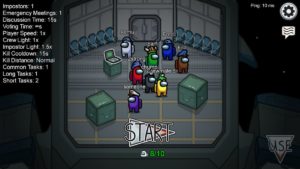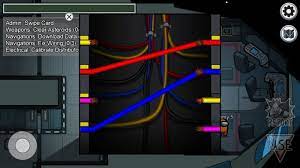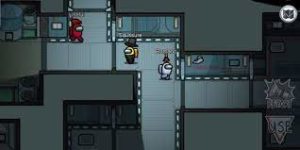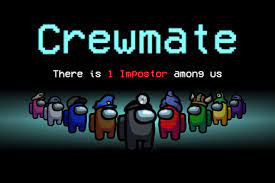Among Us
Among Us is a multiplayer game set on a spaceship. The graphic design features bold colors and simple curved shapes for the characters, and subdued colors with straight clean lines for the rooms of the ship (see Figure 1). The design choice to contrast bold and curved characters vs a subdued and linear set draws the viewers’ focus to the characters. Text is minimal, with fonts displaying information chosen to evoke old computer interfaces. Fonts on buttons for actions (Start, Kill, Report, etc) mimic handwriting. This contrast helps players determine whether text is informational or interactive.

Figure 1 The bold colors and curved shapes of the characters make them stand out from the subdued colors and straight lines of the spaceship.
Players
Among Us is a unilateral game for 4-10 players. 1 player (the Impostor), plays against the other players (Crewmates) who act as a team. This design choice makes the players focus on each other, and creates the tension that drives gameplay. The designer could have used the same graphics and many of the same mechanics to make a co-operative game where the threat was external to the ship. The design choice of a unilateral game drives many of the other decisions.
Objectives & Outcomes
The objective of the Impostor is to kill all the other players. The objectives of the Crewmates are to avoid being killed, to complete all of their assigned tasks, and to determine who the Impostor is. The game is zero-sum — either the Impostor or the Crewmates win.
These design choices follow from the decision to make this a unilateral game, and are the foundation for the fun of outwitting each other. A unilateral co-operative game would almost certainly be a contradiction in terms because you can’t have many vs one if everyone wins or loses together. An interesting design decision is that in large groups (closer to 10), there is an option to have multiple impostors, which changes the game to a multilateral or possible multi-team configuration. This change increases the chances that any given player will be in a position to have witnessed a killing.
Rules & Procedures
The Crewmates each have a list of tasks to perform. These tasks are designed to require players to visit different rooms in the ship, and to linger in particular rooms for an extended period of time. The designer included these timing elements to balance the game, so that the Impostor has enough opportunities to attack Crewmates in a vulnerable moment. If the Crewmates completes all the tasks, the Crewmates win.
The Impostor has a list of fake tasks, a design choice which makes it easier to disguise their behavior so as to appear to be a Crewmate. An impostor has the ability to kill Crewmates, and to hide.
Player Dynamics
When a Crewmate is killed, players talk to each other to share information and theories about who the Impostor is, then a vote is taken about the Impostor’s identity and one player is expelled from the game. If the Impostor was expelled, the Crewmates win, otherwise play resumes. Crewmates may also call an Emergency Meeting to discuss and hold a vote.
The designers have used this dynamic to encourage players to pay attention to each other’s comings and goings so that they have something to share and information to use when voting.
Boundaries
Players usually play remotely from each other. If they are physically in the same room, the game instructions command them to turn off sound and not to talk, except when an Emergency Meeting is called or a death is reported. Although players are supposed to chat only through text, many players use Discord to talk with each other so they can have live conversations.
Mechanics
One mechanic that works particularly well is the assigned tasks, where a player must visit a room and perform an action that takes many seconds to complete. These tasks serve several purposes: 1) tasks motivate the players to move all over the ship, 2) tasks force players to stay in one place long enough for the impostor to have an opportunity to kill them, 3) fake tasks allow the impostor to better imitate the behavior of the Crewmates, 4) tasks give players something to do when they are not directly interacting with other players. The tasks themselves are things like connecting colored wires together (see Figure 2) or calibrating an instrument. The designers again have drawn the focus of attention to within the ship. If this were a cooperative game, with external enemies, the designers would likely have chosen tasks that draw attention outward and affect the ship as a whole, such as steering the ship or firing weapons.

Figure 2 Example task. The player spends time connecting matching colors.
Another important mechanic is that players can only see the immediate room or hallway they are in. They may, however, observe the Impostor leave a room after a killing and so realize their identity. Because players have incomplete knowledge of the movements of the other players, it is more challenging and fun to deduce who the Impostor is.

Figure 3 Players cannot see each others’ movements unless they are in close proximity.
Types of Fun
The main type of fun in this game is the challenge of outwitting the other players. The game works because the designers have balanced the opportunities the Impostor has to kill the other players with the opportunities to observe a movement that will reveal the Impostor’s identity.
Improving Among Us
The game makes a nod to self expression by allowing players to personalize their characters by choosing whimsical hats. These also appear to be an opportunity for in-game purchases. I did not think the inclusion added much to the fun of the game.



